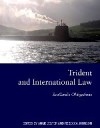By Dr. Sian Jones
“Domestic legislation designed to counter terrorism or ‘extremism’ should narrowly define these terms so as not to include forms of civil disobedience and protest; the pursuit of certain political, religious, or ideological ends; or attempts to exert influence on other sections of society, the government, or international opinion”.
When a state is in possession of nuclear weapons, the rights of its citizens are curtailed. Such states will generally adopt measures, in the name of national security, to protect those weapons from the threat of serious harm. This includes curtailing the right to protest at the military-industrial sites where nuclear weapons are manufactured, stored and deployed.
Since 2000, legislation introduced in the UK in the context of counter-terrorism and national security has, both intentionally and through over-broad drafting, restricted and criminalized protest, including anti-nuclear protest. Consequently, non-violent protest against nuclear weapons (and nuclear power installations) has been perceived through the lens of serious crime and terrorism, and anti-nuclear protesters may be considered “domestic extremists”.
This essay examines legislative and other measures – including intelligence gathering – used to limit anti-nuclear protest over the last decade; notes that where such legislation has been imposed, it has been repeatedly challenged, including in the courts; and finally examines whether it has physically, psychologically or culturally reduced the landscape of anti-nuclear protest.
The Context
The UK has been a nuclear weapons state since the 1950s, and was a founding signatory to the Nuclear Non-Proliferation Treaty in 1968. Under the 1958 Mutual Defence Agreement with the USA (renewed in 2004), the UK currently deploys a nuclear weapons system, based on the US W76 warhead design; the D5 missiles are leased from a US pool.
Warhead design, test, manufacturing and assembly facilities are located at the Atomic Weapons Establishments (AWE) Aldermaston and Burghfield in Berkshire, run as a joint venture by Lockheed Martin, Jacob’s Engineering and SERCO, on behalf of the UK government. Vanguard class submarines are based in Scotland at Her Majesty’s Naval Base (HMNB) Clyde at Faslane, and warheads are stored at the Royal Navy Armaments Depot (RNAD) Coulport. The Ministry of Defence polices each site.
The right to protest vs. national security
The right to “peaceful assembly” (the right to protest) is based in Articles 10 (Freedom of Expression) and 11 (Freedom of Assembly and Association) of the European Convention on Human Rights and Fundamental Freedoms (ECHR). The implementation of these rights is supported by the jurisprudence of the European Court of Human Rights (EctHR). In England and Wales, the ECHR is given effect in domestic law by the Human Rights Act (HRA); in Scotland, through the Scotland Act.
Articles 10 and 11 HRA state that no restriction shall be placed on those rights except “in the interests of national security or public safety, for the prevention of disorder or crime”. In most public order policing contexts the notion of security is almost always associated with the potential for protest to descend/ascend into “disorder”. Yet anti-nuclear protest in the UK is often explicitly and almost invariably non-violent, and seldom likely to amount to anything resembling disorder.
Thus in the context of protest against nuclear weapons, security means national security. Aldermaston Women’s Peace Camp (AWPC), in a submission to a parliamentary Human Rights Committee observed: “Nothing can be weighed against security concerns (because they are subjective), and because the police and government see protest itself as a security concern”. So, while Cold War anti-nuclear protesters were viewed as subversives and spies, over the past decade, measures taken against anti-nuclear protest have been in the context of anti-terrorism, and “domestic extremism”.
The measures described below were introduced, despite legislation already providing the police with a myriad of public order powers to curtail the right to protest. The police are empowered to limit protesters’ right to freedom of movement through the imposition of conditions on processions or assemblies, including by restricting routes or specifying locations for protest, and often imposing these conditions through arbitrary detention (“kettling”) of protesters. Stop and search powers also prevent or delay access to a protest location.
Powers of detention, including for breach of the peace, enable police to remove protesters, even before an action takes place, or any violence is offered. In practice this can result in arbitrary arrests, where there is no intention of taking detainees before a court, but merely releasing them only after the action is over.
Definitions of Terrorism
“The purpose qualifying such an action or threat as terrorist, i.e. advancing a ‘political, religious or ideological cause’, is also very wide and open to subjective interpretation. The definition is vaguely worded and could be extended to include supporters of, for example, animal liberation or anti-nuclear campaigns and others. The lack of a clear definition gives cause for concern because the decision to bring a prosecution for such offences could be seen to be political”.
The definition of terrorism in the Terrorism Act 2000 was sufficiently widely drawn to include anti-nuclear protest. Yet, although many activists feared that their protest would be rapidly curtailed, the Terrorism Act 2000 has been used infrequently against anti-nuclear protesters. However, in defining terrorism as serious damage to property for the purpose of influence[ing] the government or for a “political, religious or ideological cause”, the Terrorism Act expanded the meaning of “terror”.
Many explicitly non-violent anti-nuclear disarmament actions taken prior to 2000 would have fallen clearly under this definition, including the “Maytime” action against a Trident-related research barge and the destruction of testing equipment on a Trident submarine by Aldermaston Women Trash Trident.
The Terrorism Act 2000 could in theory have restricted the monitoring of activities at nuclear bases or tracking the movements of nuclear convoys, which carry warheads between the AWEs and Coulport. S. 58 (a) Terrorism Act introduced the offence of collecting or possessing “information of a kind likely to be useful to a person committing or preparing an act of terrorism”. While s.58 has not been used in an anti-nuclear context, an anti-war activist was arrested under s.58 in 2003 at a peace camp outside USAF Welford, in Berkshire, for possessing a map of the bomb-store, from where weapons convoys delivered ordnance to US aircraft operating out of Fairford during “Operation Iraqi Freedom”.
Section 44 of the Act authorised police to stop and search “for articles of a kind which could be used in connection with terrorism” (s.45.1 (a)) without the necessity of reasonable suspicion (s.45.1 (b)). While these powers were most often used in discriminatory and disproportionate searches of black and Asian people, an estimated 2,132 searches under s.44 were conducted at USAF Fairford between March-April 2003 in an attempt to shut down protest against the bombing of Iraq; S.44 was also used extensively against protesters around the 2003 DSEI Arms Fair.
Schedule 7 of the Terrorism Act 2000 has been widely criticised as a draconian stop and search power, based on ethnic profiling and primarily targeting migrant communities. Schedule 7 has also been used to target political activists, including anti-nuclear protesters. In 2008 an anti-nuclear peace activist was stopped at the UK border when returning from holiday in Germany just weeks before a major anti-NATO demonstration. He was stopped again in 2011, returning from an anti-NATO meeting in Dublin. He was detained on both occasions, for 45 minutes and 20 minutes respectively, and questioned on anti-nuclear and anti-militarist campaigns in which he was involved.
While anti-nuclear protesters certainly seek to influence the government, and some commit serious criminal damage in attempting to disarm weapons systems or associated infrastructure, is this “terrorism”? Or is the Terrorism Act 2000 an example of what the human rights NGO Peacerights has characterised as “overbroad legislation” : “…protesters are becoming the ‘unforeseen’ targets of legislation ostensibly enacted with the aim of dealing with a narrow problem such as hunt saboteurs or stalking [or “terrorism”],..which in practice are extended far beyond their originally stated intended targets. This can happen because legislation of this kind tends to be characterised by provisions which are broadly worded, ambiguous and open to a multitude of interpretations”.
Legislation at nuclear sites
In 2005 the Serious Organised Crime and Police Act (SOCPA) introduced the offence of criminal trespass on designated sites, including royal palaces, government buildings and military sites. Under the widely criticized s.132-s.138 SOCPA “unauthorized protests” in a wide area around the Houses of Parliament were criminalized. In addition, under powers granted in s.128 (3)(c), to the Secretary of State to “designate [the] site in the interests of national security”, trespass was criminalized at several Ministry of Defence (MoD) sites, including Faslane and Coulport.
According to Vernon Coaker, former Secretary of State in the Home Office, the legislation was introduced after the House of Commons Defence Select Committee noted the “absence of effective legal sanctions against persistent protesters”, following their inquiry into the MoD security response to the “terrorist” attacks of 11 September 2001: “After careful consideration it was decided to implement such an offence both as a deterrent to such intrusions and to provide the police with a specific power of arrest in such situations”.
The relevant 2002 Defence Select Committee minutes reveal that while the Ministry of Defence Police (MDP) were frustrated by their inability to prosecute trespassers at AWE Aldermaston under the Military Lands Byelaws, the then MDP Chief Constable, Lloyd Clarke, was concerned about the appropriateness of “terrorist legislation”: “… what you are asking is if they do not commit criminal damage, if they are not a terrorist threat what do we do with these individuals. I do not believe that MDP need any other legislation. I think it was certainly right we were not seeking anything under the terrorist legislation?”.
However, a member of the committee, Mr Howarth, countered: “That is not the view of your men, they were very unhappy. It is absurd to have a situation where the only remedy is an injunction. If you then have lots *** who have not done it before and they are caught in the middle of a facility and there is then no power to reprimand and prosecute those people then this is a licence to these people to come in and muck up the system. Secondly, of course, it makes it very difficult for your men to distinguish between these nuisances and the terrorists?”
Under s.12 of the Terrorism Act 2006, the provisions of s.128 were extended to Nuclear Licensed Sites (NLS) – including civil nuclear sites, nuclear power stations and “defence sites”, including AWE Aldermaston and Burghfield.
The act introduced criminal trespass to “Protected” areas of these sites, many of them previously covered by Military Lands Act byelaws. It became an offence to “enter or be on” .. “protected areas” … “as a trespasser”; the offence carried a maximum penalty of 51 weeks imprisonment and/or a £5,000 fine. Prosecution was to be authorised by the Attorney General, whose consent is required in cases related to national security.
While protesters were not defined as “terrorists”, the context in which the legislation was conceived, the enabling legislation and the extent of its provisions, clearly blurred the lines between terrorism and protest. According to Vernon Coaker: “Designation ensures that protests are conducted outside of the sites, thus reducing the risk to both protesters and police forces and preventing the activities of protesters being exploited by terrorists”.
Following the designation of sites under the Terrorism Act 2006, the MoD started to roll out a series of new byelaws, beginning at Aldermaston, covering “Protected Areas” inside, and “Controlled Areas”, mainly comprising MoD land outside the perimeter fence. In April 2006, draft byelaws were quietly put out to consultation. Although the MoD claimed that the proposed byelaws were designed to facilitate protest, they included clauses prohibiting almost all forms of non-violent protest, including meetings, assemblies and processions, the distribution of leaflets and display of placards.
This attack on the right to peaceful protest was challenged by Aldermaston Women’s Peace Camp-aign (AWPC), who succeeded in removing those clauses from the byelaws. However, further clauses remained, which prohibited camping and “attaching anything to any surface”, (which effectively prohibited hanging banners on a perimeter fence).
In June 2007, following introduction of the byelaws on 31 May, ten AWPC women were arrested outside the perimeter fence for allegedly breaking two byelaws (camping and lighting a fire). Bail conditions prohibited the women from being within a five-mile radius of AWE Aldermaston, but on 9 August, the case was dropped. In February 2008, a judicial review brought by a member of AWPC quashed the byelaw prohibiting attaching things to surfaces. Following appeal at the High Court in November 2008, in February 2009 the court revoked the prohibition on camping.
The SOCPA challenge
“Between July 2003 and June 2004 the MDP and local constabularies arrested 147 individuals for breaching the security perimeter at 23 separate establishments. The resources expended dealing with this problem were significant, and reduced the ability of the security forces concerned to deter and remain responsive to terrorist threats.
Since April 2005 when the MOD sites were designated, there have been very few incidents of criminal trespass, with only three prosecutions, two of which resulted in convictions. The resulting reduction in risk to both protestors and armed guards is considered to be a proportionate response to what was an escalating security problem”.
The act of entering a military base or nuclear establishment is perhaps one of the most symbolic acts in the lexicon of anti-nuclear and anti-militarist protest. It may, or may not, involve criminal damage but, irrespective of any other intent, it is a direct challenge to the power of the state, an act – however temporary – of non-violent occupation of land used for war. Breaking into nuclear establishments was pioneered in the 1950s by Spies for Peace; by the 1980s, as exemplified by women opposing US cruise missiles based at Greenham Common, it become not only routine, but a transformative and creative act. Bringing in a law that sought to prevent trespass was therefore bound, from its inception, to be challenged.
On 1 April 2006, the first day s. 128 SOCPA came into force, Helen John and Sylvia Boyes walked into RAF/USAF Menwith Hill in North Yorkshire, with the explicit intention of challenging the law, and in particular its application to a US establishment. After several hearings, in which they continued to question the use of SOCPA, Helen and Sylvia were convicted in October 2007, but received only suspended sentences and £50 court costs.
In September 2007, six Trident Ploughshares (TP) activists were arrested under SOCPA at Faslane in September 2007, three for climbing the fence and three others for cycling through the oil depot gate next to Faslane in another explicit challenge to the legislation. At Dumbarton Sheriffs Court on 19 March 2008, after evidence was presented, SOCPA charges against one of the first trio were dropped. She was then prosecuted for breach of the peace, and acquitted. The two others were convicted for SOCPA, but only admonished. SOCPA charges against the three others were dropped, and they were prosecuted for “Breach of the Peace” at Helensburgh District Court in March 2008, and acquitted after the court found no case to answer. According to Helen Fenton, one of the cyclists, “It seemed to me that the police were expecting that there would be unspecified but more serious consequences of our actions because it was SOCPA”.
It rapidly became clear, in Scotland at least, that while the MDP would arrest under SOCPA, the courts were disinclined to prosecute. On 17 August 2009, Sylvia Boyes and 4 other TP activists were charged with entering a SOCPA area after they walked past security guards at the north gate at Faslane, reaching the perimeter of the high security area before they were stopped by MDP. SOCPA charges were dropped, and eventually only Sylvia was prosecuted and convicted under the byelaws. Sylvia Boyes noted: “Neither Trident nor SOCPA were to be mentioned as they were not relevant to the events of that day in August”.
Similarly, two activists from Faslane Peace Camp arrested at near the High Explosives Jetty at RNAD Coulport on 14 June 2012, were originally charged with SOCPA – but subsequently prosecuted under the byelaws.. In 7 July 2012, Brian Larkin and eight others were arrested under both SOCPA and the byelaws at Faslane. Four were held overnight for court, the others “released on an undertaking”; charges against all but Brian Larkin were dropped before they appeared in court the next day; his were dropped later.
In England, at RAF/USAF Lakenheath, where US nuclear weapons were then located under NATO’s nuclear sharing agreement, eight activists entered the site in October 2006 and locked themselves to the gates of the Special Munitions Store to prevent the deployment of cluster bombs, used in raids on Afghanistan. They were arrested under SOCPA, but on conviction in December 2008 the Lakenheath 8 received only a suspended sentence and were ordered to pay £250 court costs.
At most sites, the area “Protected” area under s.128 SOCPA is contiguous with the external perimeter; at Aldermaston the “Protected” area (the Nuclear Licensed Site) includes only the land within an inner fence line. Outside the NLS, but within the external perimeter, there are playing fields, bars and a theatre to which there is public access. These areas are subject to byelaws, discussed below.
Juliet McBride of AWPC was arrested under s.128 in March 2007 while sitting on top of the inner fence at Aldermaston. In her defence she demonstrated that the MoD police had failed to correctly identify the boundary of the NLS, which was clearly shown on the map issued with the license by the regulating authority, as well as multiple signs attached to the inner fence. In August 2008, the court agreed that s.128 SOCPA applied only to the NLS, and the case against her was dismissed.
A similar failure to correctly identify the boundary of an NLS led to the acquittal in October 2008 of eight activists arrested under s. 128 SOCPA the previous April at Rolls Royce Derby, which manufactures reactor cores for Trident submarines. The eight were instead charged with aggravated trespass, when it was established that the Derby police had failed to accurately identify the perimeter of the protected area. According to Emma Bateman, “The police were adamant that the red line painted on the road was the SOCPA boundary. The police did not know the legislation. When it was clear we were going to win, the Crown Prosecution Service tried to suggest we were somehow guilty under SOCPA even though we were not charged with it”. They were eventually acquitted on the basis that the offence of aggravated trespass does not apply to land that is part of the public highway.
At Devonport in November 2010, blockaders were threatened with arrest under s. 128 SOCPA, until a legal observer was able to show the senior officer present that the blockade was outside the SOCPA designated area.
Again at Aldermaston, on 15 Feb 2010, five Trident Ploughshares activists taking part in a blockade of the site were arrested under SOCPA, after walking a few paces through Boilerhouse Gate, and briefly entering the NLS. Three were later convicted, but given only a three month conditional discharge and minimal court costs by Judge Crabtree, who stated that he “had no idea what possible public benefit there was” in bringing the prosecution.
The cases described above provide an illustrative, though not exhaustive, summary of arrests of anti-nuclear activists under SOCPA. They reveal how few arrests have resulted in prosecutions under the act, as a result of the incorrect application of the law or misinterpretation of its provisions, and how the courts have found the charge to be inappropriate, incorrect, or inconsistent with the reported intent of the law - to address “substantial trespass”. Where there have been convictions, penalties imposed have been low.
In 2009, the Human Rights Joint Committee concluded, “…we do not have confidence that section 128 has been implemented in a manner compatible with Convention rights, or that appropriate safeguards are in place to secure compatibility. We recommend that section 128(3)(c) be amended to permit the Home Secretary to designate sites on the grounds of national security only where it is necessary to do so.” In April 2012, s. 132-8 SOCPA covering “unauthorized” protests in the vicinity of parliament were repealed. S.128 remains in force.
Nukewatch
Nukewatch is a citizen verification organization, which monitors the movement of the UK’s nuclear warhead convoys and other Special Nuclear Materials (SNM) convoys.
Convoys travel along UK roads and motorways carrying warheads between the assembly and disassembly facilities at AWE Burghfield, where the warheads are periodically refurbished, and warhead storage facilities at RNAD Coulport in Scotland. The warheads are then loaded onto the UK’s Vanguard class nuclear submarines, based at nearby Faslane. SNM convoys carry nuclear materials back and forth between Aldermaston and other sites associated with the UK and US nuclear weapons and submarine programme.
Despite the potential risks to other road-users and communities through which the vehicles travel, MoD policy is neither to confirm nor deny nuclear convoy movements, including to emergency services, in the interests of “national security”.
Nukewatch has taken the pragmatic decision not to publicly announce the whereabouts of convoys while they are travelling, but only to report convoy movements after the journey is over.
Nukewatch says, “We recognise there are risks in collecting information about warhead convoys - and that the MoD and police would rather we didn’t. Our aims are to promote disarmament, and act responsibly. We’re sceptical of government rhetoric about terrorism, but we’re also aware that they could accuse us of “helping terrorists” if we make it public when the convoy is on the road”.
Domestic Extremists?
“I am … troubled by the definition of ‘domestic extremism’ as it is presently too broad, and heard real fears from peaceful protesters that they could easily be grouped in this category, along with real extremists. Indeed, some police officials, while ostensibly differentiating between extremist groups and others that use direct action, often conflate them, especially when the protest groups are horizontal”, UN Special Rapporteur on the rights to freedom of peaceful assembly and association, January 2013.
In January 2011, in the context of an ongoing complaint, a MDP Chief Inspector wrote to Juliet McBride, a member of AWPC, regarding her arrest under SOCPA (above): “As the action was politically motivated to draw attention to Trident etc, then an inference could be drawn that you were a ‘domestic extremist’ at that time. Whether you remain one is a matter for you to decide.” AWPC responded in February with a video, “Domestic extremists or domestic goddesses”, which aimed to “put the domestic back into extremism”.
Since 2003, anti-nuclear groups protesting at Aldermaston, including AWPC, Block the Builders and TP, have been under surveillance by the National Public Order Intelligence Unit (NPOIU). The same is true at other nuclear weapons sites, including Faslane. One officer, Ian Caswell, has been recorded at demonstrations at Burghfield and Aldermaston since at least 2004. He is probably seconded to the NPOIU, and associated with the National Domestic Extremism Team, which assists police forces around the country. In 2007, he was seen at Faslane365 blockades, and in November 2010 at a blockade at Devonport dockyard, where Trident submarines are refitted.
The National Public Order Intelligence Unit (NPOIU), established in March 1999, is responsible for gathering and collating intelligence in relation to “politically motivated disorder (not legitimate protests)” in England, Wales and Scotland. In 2011, it came under the control of the Metropolitan Police-led, National Domestic Extremism Unit.
There is no legal definition of domestic extremism, but according to the Association of Chief Police Officers (ACPO), “Domestic extremism and extremists are the terms used for activity, individuals or campaign groups that carry out criminal acts of direct action in furtherance of what is typically a single issue campaign. They usually seek to prevent something from happening or to change legislation or domestic policy, but attempt to do so outside of the normal democratic process.”
The ACPO definition of domestic extremism fits anti-nuclear non-violent direct action like a glove.
Police spies
Just as the Cold War anti-nuclear movement was infiltrated by M15, so post-2000 protest has been subject to police infiltration.
In January 2011, Mark Stone/Kennedy was exposed as an undercover police officer, based in the environmental movement. The revelation led to further revelations of undercover police in other protest movements, and later in January, “Lynn Watson” was exposed as an undercover police officer, who had for several years infiltrated the anti-nuclear movement. She first visited the women’s camp at Aldermaston in 2003-4, at a time of growing opposition to the development of a new generation of nuclear weapons. From there she joined Block the Builders, a new non-violent direct action group which aimed to block the construction programme at Aldermaston, joining a TP affinity group in blockades at Aldermaston, and later at Faslane. She was also active in Leeds, joining the Clown Army and targeting environmental activists, including Climate Camp. As far as her activities at Aldermaston are concerned, information gathered by Lynn Watson was never used to prevent any criminal offence or security threat; her role was to gather “intelligence” on activists involved in non-violent direct action.
In January 2013, the UN Special Rapporteur on the rights to freedom of peaceful assembly and association stated: “I must emphasize that my mandate covers only those assemblies that are non-violent. In this connection, I am deeply concerned with the use of embedded undercover police officers in groups that are non-violent and which exercise their democratic rights to protest and take peaceful direct action”.
Under surveillance
John Catt, an 87 year-old activist, has been involved for many decades in peaceful protest, including at the EDO arms factory in Brighton, but has never been arrested. In 2012, he requested a judicial review of the police’s actions in holding information on him on the National Domestic Extremist Database, which he believed had violated his right to privacy. His presence at 55 demonstrations was recorded over a four-year period, and included observations that he “took out his sketchpad and made drawings of the demonstration”, and noted his presence at an exhibition where his drawings were displayed. In March 2013, following an initial decision in favour of the police, the Appeal Court found in John Catt’s favour.
John Catt’s case illustrates the breadth of the police’s definition of domestic extremism, the degree of routine surveillance and the nature of “intelligence” gathered. Similar routine surveillance takes place at nuclear-military sites, and it should be assumed that this is exchanged with the NPOIU. At AWE Aldermaston MDP “intelligence gathering” has included: photography and video surveillance; police “liaison”; “health and safety” visits; stop and search; the recording of vehicle registration numbers, vehicle tracking and surveillance. Thames Valley Police (TVP) are also involved in surveillance, including in the local community.
In June 2011, for example, members of the public attending a viewing of the anti-nuclear film Countdown to Zero, hosted by the Nuclear Information Service in Reading, were videoed, and their number plates recorded by two TVP officers who admitted they had been instructed to “watch out for certain people”.
At large scale actions intelligence gathering may also include “informal interviews” by the MDP CID Force Intelligence Bureau (FIB), which are conducted outside of the formal interview process, and with the complicity of the custody officer. In one such interview, a Block the Builders activist was asked if she would be willing to provide the police with details of how blockades were organized and information about other protesters: especially, “Anyone we had concerns about”. Evidence gathering teams and Forward Intelligence Teams (FIT), deployed by the MDP, local police forces, and occasionally the Metropolitan Police are also present at larger actions.
Intelligence” gathering also takes place in advance of pre-planned actions through the use of “police liaison officers”. Unlike many other protest groups, some anti-nuclear activists, particularly TP, Faslane365 and currently Action AWE, have – “as part of our non-violent and peaceful process” - initiated pre-action dialogue and negotiations with the police, often at a senior level, or with a dedicated Protest Liaison Officer (PLO). The same PLOs now routinely gather intelligence, in advance of and during protests.
The UN Special Rapporteur on the rights to freedom of peaceful assembly and association has expressed concern about the dual role of PLOs: “…for this [liaison] to function effectively, it is necessary to separate the liaison function from intelligence gathering, which negates the goodwill and good relations that police liaison officers can foster by fuelling mistrust among protesters”.
Nuclear new build
The authorities continue to employ similar tactics, including in response to a new wave of protest, this time against the proposed new generation of nuclear power stations.
Following freedom of information requests, Spinwatch and the journalist Rob Edwards obtained from the Department of Energy and Climate Change (DECC), documentation of an “Activism and Nuclear New Build: Stakeholder Roundtable” held in June 2011 which revealed that the NPOIU had been gathering intelligence on activists to “manage the risk” that they posed to plans by the government and private industry to build new nuclear power stations.
According to the meeting’s agenda, NPOIU presented an “overview of the current situation and nature of the threat to DECC officials; members of the Civil Nuclear Constabulary, the three police forces in areas where new build is planned - Avon and Somerset (Hinkley Point), Suffolk (Sizewell) and North Wales (Wylfa); and representatives of three companies then involved in nuclear new build, including EDF Energy. The meeting aimed “to obtain an agreed understanding of the available intelligence on the risk to the new build programme from environmental activism” and “to identify any potential gaps in arrangements for managing the risk of direct action or protests at new build sites”.
By October 2011, Somerset and Avon police had deployed PLOs, and in March 2012, Ian Caswell of the NPOIU was running surveillance operations at a 24-hour blockade at Hinkley.
In March 2013 activists opposed to the building of Hinkley C nuclear power station, were informed by “their” PLO that the site had been granted a NLS in October 2012, and was covered under SOCPA, amended by the Terrorism Act 2006: “I thought you should be aware so that your supporters appreciate that any future action involving trespass on to the C Site would mean a criminal trespass and could result in a criminal conviction”.
Reflections
Have anti-terrorist legislation and the surveillance of “domestic extremists” restricted anti-nuclear protest? Certainly the UN Special rapporteur has observed that the changed norms of public order policing have curtailed the right to peaceful protest. But amongst those activists who have contributed to this essay, opinions differ.
Some have challenged the legislation, highlighting the irony of arresting non-violent protesters under anti-terrorist legislation, while the UK government continues to violate the Nuclear Non-Proliferation Treaty, by the possession, deployment and manufacture of nuclear weapons. Yet, for some, like Juliet McBride, the physical, psychological and legal space for protest has been curtailed:
“Personally, SOCPA has totally stopped my personal form of protest! A physical fence is part of the physical protection of the weapons and their makers; the law is made into a legal fence protecting the weapons and their makers. I have always sought to overcome the physical fence by climbing it. Likewise I have sought to overcome the physical protection of the players within the system by meeting them inside the actual fence they have erected around themselves. By this action I hope to confront the mental barriers they erect between themselves and what they do through my physical presence within the space they have marked out for themselves, and in which they practice their criminal activities. To this end I have climbed every single fence inside AWE Aldermaston and Burghfield at some time, many of them often. I did this from about 1990 – 2005 when S.128 of SOCPA became law. It was then that the legal barrier finally coincided with the physical barrier. … How ironic that moral force is totally disregarded by the law, and physical & legal force are left triumphant”.
Another activist said she would think twice about entering a SOCPA site; indeed amongst those happy to take non-violent direct action outside nuclear installations, relatively few now trespass on military-nuclear sites. Sylvia Boyes, convicted under SOCPA observed, “I think the SOCPA legislation has worked, in as much it has made people hesitate about trying to enter the areas covered,” and others have suggested that it deters those new to direct action.
However, others – like Jane Tallents of TP, active at Faslane – have been encouraged by the ineffectiveness of the legislation in practice, “It seems like SOCPA was designed to frighten protesters from entering military bases. However after the first prosecution in Scotland when the head Procurator Fiscal himself took the case and Emma defended herself so brilliantly the police may continue to charge people with SOCPA, but the courts don’t prosecute it. The Sheriff in that first case said that they were not entitled to enter a designated area but that they had caused no danger and only inconvenienced police who were on patrol anyway so the great threat of a year in prison melted away as they were admonished”.
Emma Bateman, arrested three times under SOCPA concurs, “Although I was initially worried when I was arrested under SOCPA the first time because we didn’t know how harsh the penalties would be, I am not especially concerned about SOCPA. It would not put me off taking action because fines and costs in magistrates courts are quite arbitrary (seems to be down to whether the judge is having a bad day at the office or not) and I have been fined more for other offences than I have for SOCPA”.
For some, SOCPA – unlike Trident – is a deterrent; for others it’s business as usual. While considerably fewer people now trespass on nuclear and military sites than the 147 cited by the MoD in 2003-4, the culture of protest has changed. Rather than SOCPA or surveillance, other factors including new social movements and campaigns, digital activism and a less vibrant anti-nuclear movement have reduced the landscape of anti-nuclear protest. But while they may be fewer in number, some “nuts” remain impervious to the sledgehammer, and it will take more than anti-terrorist legislation to curtail their right to protest.

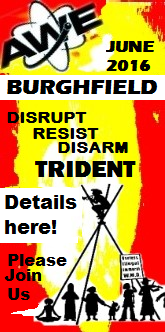
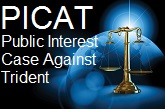
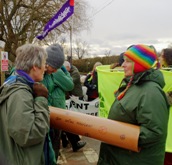







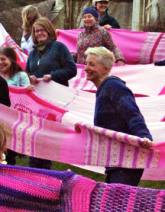
 Nuclear weapons crime in the UK has been reported to Thames Valley Police.
Nuclear weapons crime in the UK has been reported to Thames Valley Police.









